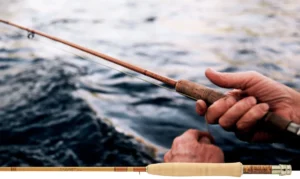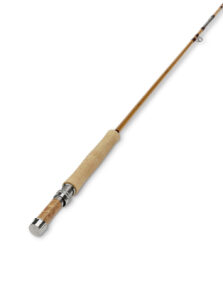Key Takeaways
-
Classes in 2024 are designed to cater to various skill levels, ensuring a comprehensive learning experience.
-
Choosing the right bamboo fly rod building class depends on personal goals and previous experience.
-
Hands-on instruction is crucial for mastering the intricate craft of bamboo rod building.
-
Quality materials and tools are essential for creating a rod that stands the test of time.
Why Choose Bamboo for Your Fly Rod
So, why bamboo? Besides the rich history and the satisfying ‘whoosh’ as it cuts through the air, bamboo fly rods provide a level of sensitivity and flex that modern materials struggle to match. Here’s the deal:
-
Bamboo rods are known for their smooth casting action, making them a joy to use on the water.
-
The natural material has an aesthetic appeal that stands out from the synthetic crowd.
-
Each rod is unique, with its own character, much like the anglers who wield them.
But don’t be fooled by their classic looks; bamboo rods can compete with the best of today’s technology, offering precision and strength where it counts.
Popular Bamboo Fly rod Classes
|
Class |
Price Range |
Location |
Features |
|---|---|---|---|
|
Tom Morgan Rodsmiths’ Bamboo Rod Building |
$2,500 – $3,000 |
Bozeman, Montana |
Week-long class at their shop with experienced rod builders, comprehensive training in bamboo rod making |
|
Kretchman Fly Rods |
$2,100 |
Kittery Point, Maine |
Hands-on experience to fully complete your a custom rod |
|
Bill Oyster’s Bamboo Rod Making Class |
$1,800 |
Blue Ridge, GA |
7-day class taught by Bill Oyster starting with raw bamboo culms and leaving with a fully finished rod |
|
L. Jim Downes’ One-on-One Classes |
Varies |
Central Pennsylvania |
Personalized, small classes near Penns Creek for a focused learning experience |
|
Harry Boyd’s Ozark Rodbuilding Class |
Varies |
Missouri |
Ideal for those preferring one-on-one classes; recommended for a detailed learning experience |
Choosing the Right Class for You
What To Look For When Selecting Your Class
Bamboo fly rod building classes are more than just a step-by-step guide; they’re an immersive experience that will take you from enthusiast to craftsman. Here’s what you can expect:
-
Instructors with a wealth of experience who live and breathe the craft.
-
A curriculum that balances tradition with modern techniques.
-
Small class sizes to ensure personalized attention and in-depth learning.
-
High-quality materials provided, so you start with the best foot forward.
-
A finished product that you can proudly say was made by your own two hands.
Whether you’re looking to build a rod for your own collection or to start a journey into professional rod building, these classes are the gateway to your ambition.
Before you dive in, it’s important to choose a class that aligns with your goals and current skill level. Are you a beginner looking to get your feet wet, or an experienced rod builder seeking to refine your skills? Either way, there’s a class tailored for you.
Identifying Your Skill Level
First things first, assess where you stand:
-
If you’ve never touched a rod building tool before, look for beginner classes that cover the basics.
-
For those with some experience, intermediate classes can introduce more complex techniques.
-
Seasoned rod builders might opt for advanced workshops that delve into the nuances of the craft.
Knowing your level will ensure you’re not out of your depth or bored with repetition. And remember, there’s no shame in starting at the beginning. Even the most skilled artisans had to start somewhere.
Comparing Class Curriculums
Now, let’s compare what different classes offer. You’ll want to look at several key factors:
-
The length of the class – will you be building a rod in a weekend or over several weeks?
-
The focus of the curriculum – does it emphasize traditional hand-planing techniques or incorporate modern tools?
-
The size of the class – will you be one of a few, ensuring plenty of one-on-one instruction?
By considering these elements, you can find a class that not only fits your schedule but also matches your learning style and objectives.
Hands-On Instruction Techniques
When you’re learning to build a bamboo fly rod, there’s no substitute for rolling up your sleeves and getting your hands dirty. That tactile experience of working with bamboo, feeling its fibers, and understanding its behavior is what turns a good rod builder into a great one. The best classes offer a mix of demonstration and practice, allowing you to see techniques up close and then try them yourself.
Personalized Feedback and Guidance
As you progress through your class, personalized feedback from the instructor is invaluable. They’ll help you refine your technique, correct any missteps, and provide tips tailored to your style. This individual attention ensures that you’re not just following steps but truly understanding the craft.
With the right guidance, you’ll learn not only how to perform each step but also why it’s important. This depth of knowledge is crucial for troubleshooting and innovating in your future rod-building endeavors.
Moreover, as you work through the nuances of rod building, your instructor will help you develop a keen eye for detail—vital for ensuring that each piece of your rod fits together seamlessly. It’s this level of craftsmanship that sets handmade rods apart from mass-produced ones.
For example, one student struggled with getting the nodes on the bamboo to align perfectly. With a bit of personalized advice, they learned a new filing technique that made all the difference. Now, that student crafts rods that are not only functional but also visually stunning.

Tom Morgan Rodsmiths https://tommorganrodsmiths.com/
Tools and Techniques: Traditional vs. Modern Approaches
In the world of bamboo fly rod building, there’s a delicate balance between tradition and innovation. While the heart of the craft lies in the time-honored techniques that have defined it for centuries, modern tools and approaches can enhance precision and efficiency.
History and Evolution of Bamboo Rod Building Tools
The tools of the trade have a rich history, from simple planing forms to intricate binding machines. These tools have evolved as rod builders have sought to perfect the balance and action of their rods. Understanding the history of these tools isn’t just about appreciating the craft; it’s about recognizing the wisdom in the methods developed over time.
Incorporating New Technologies in Traditional Crafting
But just because something is traditional doesn’t mean it can’t be improved. The best classes of 2024 don’t shy away from new technologies; they embrace them. Whether it’s using laser-guided cutting tools for precision or integrating software to model rod action, modern advancements have a place alongside the tried-and-true.
Sourced and Sustainable: Materials Beyond Bamboo
While bamboo is the star of the show, sustainability in all materials is a growing concern. Many classes now emphasize the importance of using resources that are responsibly harvested and produced. This not only ensures the longevity of the craft but also protects the environments we love to fish in.
From silk thread for wrapping guides to natural rubber for grips, every component has a story. Choosing materials that align with conservation efforts means your rod isn’t just a tool for fishing—it’s a statement of stewardship.
Workshop Insights: From Novice to Artisan
The journey from a novice to an artisan is filled with learning and discovery. The workshop is where you’ll experience the transformation, surrounded by fellow enthusiasts and guided by masters of the craft.
Troubleshooting Common Obstacles in Rod Building
As with any craft, you’ll encounter obstacles along the way. Maybe it’s a strip of bamboo that just won’t straighten, or a guide that refuses to sit flush. The key is to not get discouraged.
These classes will equip you with the knowledge to overcome these challenges. Whether it’s adjusting your technique or rethinking your approach, there’s always a solution. And often, it’s these very challenges that lead to the greatest leaps forward in your skill.
So there you have it. With the right class, tools, and materials, you’re well on your way to building not just a bamboo fly rod, but a legacy. In the final section of this article, we’ll look at how to continue your craftsmanship journey long after the class is over.
After the Class – Continuing Your Craftsmanship Journey
Once the dust settles and the last coat of varnish dries, your bamboo fly rod building class may be over, but your journey as a craftsman is just beginning. The skills you’ve acquired are the foundation for a lifetime of crafting and fishing. But what’s next? How do you take what you’ve learned and continue to grow?
Joining Communities and Growing Your Network
One of the most enriching steps you can take is to join a community of fellow rod builders. These communities are invaluable for sharing experiences, exchanging tips, and offering support. You’ll find that the rod-building community is a welcoming place, full of individuals who are passionate about preserving the tradition and eager to help newcomers.
Whether it’s online forums, local clubs, or social media groups, connecting with others will open up a world of resources. You can participate in rod-building challenges, attend meetups, and even collaborate on projects. This network isn’t just a source of information; it’s a wellspring of inspiration.
Maintenance, Repair, and Upgrading Your Handmade Rods
As you continue to fish with your bamboo fly rod, you’ll inevitably need to perform maintenance and repairs. This is an essential part of the rod’s lifecycle and another opportunity to deepen your understanding of its construction. From replacing a guide to rewrapping a section, each repair will refine your skills.
And as you grow more confident, you might even consider upgrading your rod with new components or refinements. Perhaps you’ll add an intricate inlay or experiment with different varnishes to enhance the rod’s performance and appearance.

Kretchman Fly Rods https://www.kretchmanflyrods.com/
FAQs
Are Bamboo Fly Rod Building Classes Suitable for Absolute Beginners?
Absolutely! These classes are designed to welcome those who have never held a planing tool before. Instructors are skilled at demystifying the process, breaking down each step into manageable tasks. You’ll be guided through selecting bamboo, shaping it, and assembling your rod—all with the patience and expertise you need to succeed.
How Much Time Investment Is Required for Mastering Bamboo Fly Rod Building?
Mastering any craft takes time, and bamboo fly rod building is no different. However, with a week-long class, you can expect to complete your first rod and understand the basic techniques. From there, practice is key. The more rods you build, the more proficient you’ll become. Think of it like learning a musical instrument—the joy is in the journey.
-
Beginner classes typically last a week and result in a finished rod.
-
Practice outside of class is essential for honing your skills.
-
Advanced techniques and mastery may require additional classes or workshops.
What Are the Differences Between Online and In-Person Classes?
Online classes offer flexibility and convenience, allowing you to learn from anywhere. They can be great for theory and understanding the principles behind rod building. However, in-person classes provide hands-on experience and direct feedback that’s hard to replicate digitally. The tactile nature of working with bamboo is best experienced firsthand.
Can I Really Make a Rod Comparable to High-end Store-Bought Models?
With dedication and attention to detail, the rod you build can indeed rival high-end models. Handcrafted rods have a personal touch and a level of customization that mass-produced rods can’t match. Plus, the satisfaction of catching a fish with a rod you’ve made yourself is priceless.
Are There Age Requirements for These Classes?
While there’s no strict age limit, rod building does require a certain level of dexterity and patience. It’s typically recommended for teenagers and adults. If you’re considering enrolling a younger enthusiast, check with the class provider to ensure it’s a good fit.
In conclusion, bamboo fly rod building classes offer a gateway into a world where tradition meets craftsmanship. They are a testament to the enduring allure of fly fishing and the timeless appeal of handcrafted gear. As you venture forth with your new skills, remember that every strip of bamboo you plane, every guide you wrap, and every cast you make is part of a storied legacy—one that you are now a part of.
So, take pride in your work, share your knowledge, and above all, enjoy the serene moments on the water with a rod that’s an extension of your own craft and creativity. Tight lines and happy crafting!
For those interested in the art of fly fishing, bamboo rod building classes offer a hands-on way to learn about crafting your own fishing rods from bamboo, a material renowned for its strength, flexibility, and beauty. These classes can range from beginner to advanced levels and typically cover the entire process, from selecting the bamboo to the final finishing touches of creating a functional and aesthetically pleasing fly rod.

“Ihr 4-Sterne-Hotel Post in Nauders” from www.post-nauders.com and used with no modifications.




